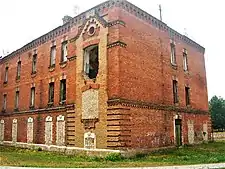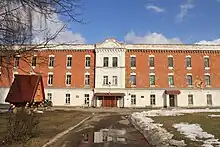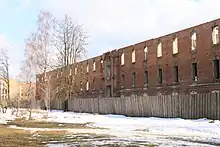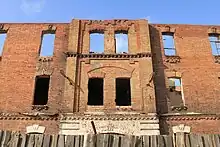Bereza Kartuska Prison
| Bereza Kartuska | |
|---|---|
| Concentration camp | |
 Main building. | |
 Location of Bereza Kartuska within Poland | |
| Coordinates | 52°33′N 24°58′E |
| Location | Bereza Kartuska, Polesie Voivodeship |
| Built by | Second Polish Republic |
| Operated by | Polish police force |
| Original use | Political and criminal prison |
| Operational | 1934—1939 |
| Inmates | National Democrats, communists, members of the Polish People's Party, Ukrainian and Belarusian nationalists |
| Number of inmates | More than 3000 |
| Liberated by | Abandoned, 17 September 1939 |
Bereza Kartuska Prison (Miejsce Odosobnienia w Berezie Kartuskiej, "Place of Isolation at Bereza Kartuska")[1] was operated by Poland's Sanation government from 1934 to 1939 in Bereza Kartuska, Polesie Voivodeship (today, Biaroza, Belarus).[2][3][4][5] Because the inmates were detained without trial or conviction, it is considered an internment camp[6] or concentration camp.[7][8][9]
Bereza Kartuska Prison was established on 17 June 1934 by order of President Ignacy Mościcki[10] to detain persons who were viewed by the Polish state as a "threat to security, peace, and social order"[10] or alternately to isolate and demoralize political opponents of the Sanation government such as National Democrats, communists, members of the Polish People's Party, and Ukrainian and Belarusian nationalists. Prisoners were sent to the camp on the basis of an administrative decision, without formal charges, judicial sanction, or trial, and without the possibility of appeal.[11] Prisoners were detained for a period of three months, with the possibility of indefinite extension.[12]
Detainees were expected to perform penal labour. Often prisoners were tortured, and at least 13 prisoners died.[11]
Besides political prisoners, starting in October 1937 recidivists and financial criminals were also sent to the camp.[12] During the German invasion of Poland in September 1939, the camp guards fled on news of the German advance, and the prisoners were freed.[13]
History

It was created on July 12, 1934, in former Russian barracks and prison at Bereza Kartuska on the authority of a June 17, 1934, order issued by Polish President Ignacy Mościcki. The event that directly influenced Poland's de facto dictator, Józef Piłsudski, to create the prison was the assassination of Polish Minister of Internal Affairs Bronisław Pieracki on June 15, 1934, by the Organization of Ukrainian Nationalists (OUN).[14] It was intended to accommodate persons "whose activities or conduct give reason to believe that they threaten the public security, peace or order."[10]
The Bereza Kartuska prison was organized by the director of the Political Department of the Ministry of Internal Affairs, Wacław Żyborski, and the head of that Department's Nationalities Section (Wydział Narodowościowy), Colonel Leon Jarosławski. The institution was later supervised by the Governor of Polesie Province, Colonel Wacław Kostek-Biernacki.[15] In the view of some historians, Kostek-Biernacki did not serve as commandant; they identify its commandants as police inspectors Bolesław Greffner (whose given name is sometimes stated as "Jan"), of Poznań, and Józef Kamala-Kurhański.[16] Officially, Bereza Kartuska was not a part of Poland's penitentiary system, and the staff was composed of policemen, sent there as a punishment, rather than professional prison guards.

Individuals were incarcerated at Bereza Kartuska by administrative decision, without right of appeal, for three months, although this term was often extended while Colonel Wacław Kostek-Biernacki served as its commander.[15] The average prisoner would spend 8 months in the camp.[17] In the first three years of its history, the camp incarcerated people perceived as subversives and political opponents of the ruling Sanation regime. Recidivists and financial criminals were also detained starting from October 1937.[12] Citizens suspected of pro-German sympathies were first detained in Bereza in the middle 1938.[18] In the first days of the September Campaign of 1939, Polish authorities started mass arrests of people suspected of such sympathies.[19] Some members of the German minority in Poland were detained in whole families, including women (previously never detained in the camp).[19]
The camp de facto ceased to exist on the night of September 17–18, 1939 when, after learning about the Soviet invasion of Poland, the staff had abandoned it.[20] According to two reports, the departing policemen murdered some prisoners.[21]
Inmates

According to the surviving documentation of the camp, more than 3000 people were overall detained in Bereza Kartuska from July 1934 until August 29, 1939.[22] However, the camp's authorities stopped formally registering detainees in September 1939, after mass arrests began.[23] According to incomplete data from Soviet sources, at least 10,000 people had gone through the prison.[24]
Reasons for arrest
Prisoners included members of the Organization of Ukrainian Nationalists (OUN), Polish Communist Party (KPP) and National Radical Camp (ONR), as well as members of the People's Party (SL) and Polish Socialist Party (PPS). The detainees included Bolesław Piasecki and, for some dozen days, the journalist Stanisław Mackiewicz (the latter, paradoxically, a warm supporter of the prison's establishment). Also a number of Belarusians who had resisted Polonization found themselves in the camp.[25]
The first inmates - Polish ONR activists - arrived on July 17, 1934. A few days later, OUN activists arrived: Roman Shukhevych, Dmytro Hrytsai and Volodymyr Yaniv.[26] By August 1939, Ukrainians constituted 17 percent of prisoners.[27]
In April 1939, 38 members of Karpacka Sicz organization were detained in the camp.[28] They were ethnic Ukrainians, previously residing in the Carpathian Ruthenia region of Czechoslovakia, where they were attempting to create an independent Ukrainian state. After this region was annexed by Hungary, Hungarian authorities deported them to Poland, whey they were sent to Bereza Kartuska. Unlike other prisoners, they didn't have to perform any labours and had the right to freely talk to each other in low voice.[28]
Reason for detention by percentage of inmates:[23]
| 1934 | 1935 | 1936 | 1937 | 1938 | I-VIII 1939 | Summary | |
|---|---|---|---|---|---|---|---|
| Communists | 70% | 66% | 100% | 73% | 39% | 50% | 55% |
| Far-right parties' members | 10% | 17% | - | - | - | - | 2% |
| Ukrainian nationalists | 30% | 17% | - | - | - | - | 4% |
| Peasant parties' activists | - | - | - | - | 1% | - | 1% |
| Nazism supporters | - | - | - | - | 1% | - | 1% |
| "Anti-state activists" (szkodnicy) | - | - | - | - | - | 1% | ≈0% |
| Karpacka Sicz members | - | - | - | - | - | 2% | ≈0% |
| Criminals | - | - | - | 23% | 55% | 41% | 35% |
| Financial criminals | - | - | - | 4% | 4% | 6% | 2% |
Known inmates
- Polish nationalists - Zygmunt Dziarmaga, Władysław Chackiewicz, Jan Jodzewicz, Edward Kemnitz, Bolesław Piasecki, Mieczysław Prószyński, Henryk Rossman, Bolesław Świderski, Witold Borowski, Stanisław Mackiewicz, Adam Doboszyński, Leon Mirecki
- Polish communists - Henryk Bromboszcz, Leib Dajez, Abram Germański (died there), Leon Pasternak, Marek Rakowski, Aron Skrobek, Szymon Dobrzyński (aka "Eckstein")
- Ukrainian nationalists - Taras Bulba-Borovets, Dmytro Dontsov, Dmytro Hrytsai, Dmytro Klyachkivsky, Hryhory Klymiv, Omelian Matla, Roman Shukhevych, Mykhailo Yaniv, Volodymyr Yaniv, Bohdan Pashkovskyi
- Ukrainian communists - Włodzimierz Sznarbachowski
- Belarusian nationalists - Viachaslau Bahdanovich, Uladzislau Pauliukouski, Juljan Sakovich
- Others - Orest Kazanivsky, Leonard Malik, Jan Mozyrko (died there), Janka Shutovich
Conditions
From 1934 to 1937, the facility usually housed 100–500 inmates at a time. In April 1938 the number went up to 800.[29] In early 1938, the Polish government suddenly increased the number of inmates by sending 4,500 Ukrainian nationalists, terrorists, and members of Organization of Ukrainian Nationalists to Bereza Kartuska without the right of appeal.[26]
Conditions were exceptionally harsh, and only one inmate managed to escape.[30] Only one suicide occurred; on 5 February 1939, inmate Dawid Cymerman slit his throat in a toilet.[31] The number of deaths in detention was kept artificially low by releasing prisoners who were in poor health.[32] According to Śleszyński, 13 inmates died during the facility's operation, most of them at a hospital in Kobryń.[31][33] In other sources, the total number of deaths, is variously given as between 17 and 20.[34] This number is also repeated in recent sources; for example, Norman Davies in God's Playground (1979) gives the number of deaths as 17.[35] Ukrainian historian, Viktor Idzio, states that according to official statistics, 176 men – by unofficial Polish statistics, 324 Ukrainians – were murdered or tortured to death during questioning, or died from disease, while escaping, or disappeared without a trace. According to Idzio, most were OUN members.[26]
OUN members who were incarcerated at Bereza Kartuska testified to the use of torture. There were frequent beatings (with boards being placed against inmates' backs and struck with hammers), forced labor, constant harassment, the use of solitary confinement without provocation, punishment for inmates' use of the Ukrainian language, etc.[26] By the time they were released from Bereza Kartuska, many Ukrainians had had their health destroyed or had died. Taras Bulba-Borovetz, who later became otaman of the Ukrainian Insurgent Army (UPA), developed epilepsy as a result of his stay in Bereza Kartuska.[26]
Prisoners were accommodated within the main compound, in a three-story brick building. A small white structure served for solitary confinement (in Ukrainian, "kartser"; in Polish, "karcer"). South of the solitary-confinement structure was a well, and south of that was a bathing area. The whole compound was encircled by an electrified barbed-wire fence. Across a road from this compound were the commandant's house and officers' barracks. In the prisoners' building, each cell initially held 15 inmates. There were no benches or tables. In 1938 the number of inmates per cell was increased to up to 70. The floors were of concrete and were constantly showered with water so that inmates could not sit.[26]
Kazimierz Baran wrote that "the rigour detectable in Beraza Kartuska camp can by no means be compared with the dreadful conditions of the Nazi or Soviet-organized labour camps".[36]
Naming
The Polish government called the institution "Miejsce Odosobnienia w Berezie Kartuskiej" ("Place of Isolation at Bereza Kartuska"). From the facility's inception, the Sanation government's opponents openly criticized the legal basis for its establishment and operation, calling it a "concentration camp."[37] This term was also used by Western media sources such as The Times, both during the interbellum[38] and immediately after World War II.[39] It was later popularized by communist propaganda,[40] which cited the prison as evidence that Poland's prewar government had been a "fascist" regime.[41][42] In 2007, the Polish Embassy objected to the use of the term in a memorial plaque in Paris for the Bereza Kartuska inmate Aron Skrobek. Its objections were successful and the plaque instead described the facility as a seclusion camp.[43]
Modern scholarship has characterized the facility as a concentration camp,[44][45][46][47][48][49][50][51][52] including Yale University professor Timothy Snyder,[53] the United States Holocaust Memorial Museum,[54] the Library of Congress,[55] Polish Nobel prize-winning author Czesław Miłosz,[56] and historian Karol Modzelewski, who was political prisoner and one of the leaders of the democratic opposition in the communist Poland.[57] Ukrainian sources such as Kubijovych and Idzio representing the Ukrainian Nationalist camp of the interpretation of history also categorize Bereza Kartuska as a concentration camp.[58] Polish-American historian Tadeusz Piotrowski who also calls it a concentration camp, notes that the establishment of the facility was a norm of its times, similar to other facilities where political opponents were locked up, often in an extrajudicial manner. (Like the giant German or Soviet networks of concentration camps, degrees of brutality and number of prisoners aside.) [35][59] Describing Bereza Kartuska as a concentration camp may be against the Polish Holocaust law, according to historian Tomasz Stryjek.[60]
References
- Misiuk, Andrzej (2007). "Police and Policing Under the Second Polish Republic, 1918–39". Policing Interwar Europe: 159–171. doi:10.1057/9780230599864_8. ISBN 978-1-349-54365-6.
- Rossolinski, Grzegorz (October 2014). Stepan Bandera: The Life and Afterlife of a Ukrainian Nationalist. Columbia University Press. pp. 167, 168. ISBN 9783838266848.
- Howansky Reilly, Diana (2013). Scattered: The Forced Relocation of Poland's Ukrainians After World War II. University of Wisconsin Press. p. ix. ISBN 9780299293437.
- Ravel, Aviva (1980). Faithful Unto Death: The Story of Arthur Zygielbaum. Workmen's Circle. pp. 42, 43. ISBN 9780969043508.
- Misiuk, Andrzej (2007). "Police and Policing Under the Second Polish Republic, 1918–39". Policing Interwar Europe: 159–171. doi:10.1057/9780230599864_8. ISBN 978-1-349-54365-6.
- Norman Davies (24 February 2005). God's Playground A History of Poland: Volume II: 1795 to the Present. OUP Oxford. p. 302. ISBN 978-0-19-925340-1.
- Marples, David R. (2010). "Anti-Soviet Partisans and Ukrainian Memory". East European Politics and Societies and Cultures. 24 (1): 26–43. doi:10.1177/0888325409354908. S2CID 144394106.
- Copsey, Nathaniel (2008). "Remembrance of Things Past: the Lingering Impact of History on Contemporary Polish–Ukrainian Relations". Europe-Asia Studies. 60 (4): 531–560. doi:10.1080/09668130801999847. S2CID 144530368.
- Misiuk, Andrzej (2007). "Police and Policing Under the Second Polish Republic, 1918–39". Policing Interwar Europe: Continuity, Change and Crisis, 1918–40. Palgrave Macmillan UK. pp. 159–171. ISBN 978-0-230-59986-4.
- Śleszyński 2003a, p. 16.
- Śleszyński 2003a, p. 53.
- Śleszyński 2003a, p. 85.
- Braun, Connie T. (26 September 2017). Silentium: And Other Reflections On Memory, Sorrow, Place, and the Sacred. pp. 64, 65. ISBN 9781498243018.
- (in Polish) Andrzej Misiuk BIAŁYM ŻELAZEM Archived January 15, 2008, at the Wayback Machine, Gazeta Wyborcza, 12/07/1994
- Jerzy Jan Lerski; Piotr Wróbel; Richard J. Kozicki (1996). Historical dictionary of Poland, 966-1945. Greenwood Publishing Group. p. 33.
- Mikołaj Falkowski (2008). "Wacław Kostek-Biernacki". HISTORIA.polskieradio.pl (in Polish). Polish Radio. Retrieved 2010-01-13.
- Śleszyński 2003a, p. 100.
- Śleszyński 2003a, p. 90.
- Śleszyński 2003a, p. 91.
- Śleszyński 2003a, p. 92.
- Śleszyński 2003a, p. 93.
- Śleszyński 2003a, p. 83
- Śleszyński 2003a, p. 84
- Ladusev U.F. Communist party of Western Belarus as organizer of workers struggle for democratic rights and freedoms. Minsk, 1976, Page 24.
- Jan Zaprudnik, "Belarus: At a Crossroads" (1993, ISBN 0-8133-1794-0), p. 85
- Viktor Idzio, Ukrainska Povstanska Armiya: zhidno zi svidchennia nimetskykh ta radianskykh arkhiviv (The Ukrainian Insurgent Army: Gleanings from German and Soviet Archives), Lviv, 2005, ISBN 966-665-268-4, p. 6.
- G. Motyka, Ukraińska partyzantka, 1942-1960, PAN, 2006, p. 65
- Śleszyński 2003a, p. 88.
- Śleszyński 2003a, p. 84.
- Śleszyński 2003b, 48.
- Śleszyński 2003b, 49.
- Śleszyński 2003a, p. 51.
- Śleszyński gives the full names of the deceased inmates, as well as the dates of their deaths and their camp numbers.
- Zdzisław J. Winnicki, "Bereza Kartuska – jak było naprawdę?", 2008 Archived February 26, 2010, at the Wayback Machine
- Norman Davies, God's Playground: A History of Poland, Columbia University Press, 2005, ISBN 0-231-12819-3, Google Print, p. 316.
- Kazimierz Baran (2010). Constitutional Developments of the Habsburg Empire in the Last Decades before its Fall: The Materials of Polish-Hungarian Conference. Cracow, September 2007. Wydawnictwo UJ. p. 12. ISBN 978-83-233-8026-9.
- Śleszyński 2003a, p. 151.
- The Times "Anti-Jewish Agitation in Poland". Archived from the original on 2011-07-22. Retrieved 2009-12-02. March 24, 1938
- The Times "M. Biernacki to be tried" November 23, 1946
- Lagzi 2004, 203.
- Richard M. Watt, Poland and Its Fate, 1918 to 1939, New York, Simon and Schuster, 1979, p. 302.
- Morawiec, Arkadiusz (January 2019). "After Bereza. Polish literature towards the Confinement Centre in Bereza Kartuska. 1939–2018". Acta Universitatis Lodziensis. Folia Litteraria Polonica. 55 (4): 273–309. doi:10.18778/1505-9057.55.14. S2CID 242909153.
- "Intervention of the Embassy of Poland in Paris against the term "Polish concentration camp" used on the memorial plaque for Aron Skrobek. December 2007, Paris". Ministry of Foreign Affairs of the Republic of Poland. Retrieved 2009-12-28.
- Marples, David R. (2007). Heroes and Villains: Creating National History in Contemporary Ukraine. Central European University Press. pp. 87, 133. ISBN 978-963-7326-98-1.
- Keller, Lech (2002). "Non-Science Fiction Prose of Stanislaw Lem". The Soviet and Post-Soviet Review. 29 (3): 241–256. doi:10.1163/187633202X00035.
- Marples, David R. (2010). "Anti-Soviet Partisans and Ukrainian Memory". East European Politics and Societies and Cultures. 24 (1): 26–43. doi:10.1177/0888325409354908. S2CID 144394106.
- Copsey, Nathaniel (2008). "Remembrance of Things Past: the Lingering Impact of History on Contemporary Polish–Ukrainian Relations". Europe-Asia Studies. 60 (4): 531–560. doi:10.1080/09668130801999847. S2CID 144530368.
- Misiuk, Andrzej (2007). "Police and Policing Under the Second Polish Republic, 1918–39". Policing Interwar Europe: Continuity, Change and Crisis, 1918–40. Palgrave Macmillan UK. pp. 159–171. ISBN 978-0-230-59986-4.
- Magierowski, Mateusz (2016). "(A)symmetry of (Non-)memory: The Missed Opportunity to Work Through the Traumatic Memory of the Polish–Ukrainian Ethnic Conflict in Pawłokoma". East European Politics and Societies. 30 (4): 766–784. doi:10.1177/0888325416651328. S2CID 147713876.
- Marples, David R. (1999). Belarus: A Denationalized Nation. Taylor & Francis. p. 7. ISBN 978-90-5702-343-9.
- Reilly, Diana Howansky (2013). Scattered: The Forced Relocation of Poland's Ukrainians After World War II. University of Wisconsin Press. p. ix. ISBN 978-0-299-29343-7.
- Melzer, Emanuel (1997). No Way Out: The Politics of Polish Jewry 1935-1939. Monographs of the Hebrew Union College. p. 7. ISBN 978-0-87820-141-9.
- Timothy Snyder, The Reconstruction of Nations: Poland, Ukraine, Lithuania, Belarus, 1569–1999., 2004.,
- "Collections Search - Bereza Kartuska (Concentration camp)". United States Holocaust Memorial Museum. Retrieved 26 September 2020.
- Library of Congress Subject Headings.
- Czesław Miłosz, The History of Polish Literature, New York, Macmillan, 1969, p. 383: "Pilsudski soon revealed himself as a man of whims and resentments... He founded a concentration camp, where he sent several members of the Diet."
- Kalina Błażejowska (7 November 2018). "Prof. Modzelewski: Za rodaków wstydzi się tylko patriota". Magazyn Opinii Pismo. Retrieved 15 December 2018.
- (Ukrainian) Idzio, Viktor (2005). Ukrainska Povstanska Armiya – zhidno zi svidchennia nimetskykh ta radianskykh arkhiviv (The Ukrainian Insurgent Army, according to Testimony in German and Soviet Archives). ISBN 966-665-268-4.
- Tadeusz Piotrowski, Poland's Holocaust: Ethnic Strife, Collaboration with Occupying Forces and Genocide in the Second Republic, 1918–1947, McFarlandMcFarland, 1998, ISBN 0-7864-0371-3, p.193
- Stryjek, Tomasz (2018). "The Hypertrophy of Polish Remembrance Policy after 2015: Trends and Outcomes". Zoon Politikon. 1 (9): 43–66. doi:10.4467/2543408XZOP.18.003.10059. ISSN 2082-7806.
Such threats [of prosecution under the memory law] also concern researchers who use the term "concentration camp" in relation to crimes committed by Polish state officials, consisting in creating conditions resulting in death from illness, starvation and exhaustion of political prisoners. It applies to camps in: Bereza Kartuska (1934-1 939), officially a "place of detention", Świętochłowice-Zgoda (in 1945, detaining mainly Germans and Silesians) and Jaworzno (1945-1949, from 1947 used for Ukrainians and Lemkos deported under the "Vistula" action), called "labour camps" ( Łuszczyna 2017).
Further reading
- (in Polish) "Bereza Kartuska," Encyklopedia Polski (Encyclopedia of Poland), p. 45.
- Idzio, Viktor (2005). Ukrainska Povstanska Armiya - zhidno zi svidchennia nimetskykh ta radianskykh arkhiviv (The Ukrainian Insurgent Army, according to Testimony in German and Soviet Archives) (in Ukrainian). Lviv: Spolom. ISBN 966-665-268-4.
- Lagzi, Gábor (2004). "The Ukrainian Radical National Movement in Inter-War Poland - the Case of Organization of Ukrainian Nationalists (OUN)". Regio - Minorities, Politics, Society (1): 194–206.
- Polit, Ireneusz (2003). Obóz odosobnienia w Berezie Kartuskiej 1934–39 (The Bereza Kartuska Isolation Camp, 1934–39) (in Polish). Toruń: Adam Marszałek. ISBN 83-7322-469-6.
- Siekanowicz, Piotr (1991). Obóz odosobnienia w Berezie Kartuskiej 1934–39 (The Bereza Kartuska Isolation Camp, 1934–39) (in Polish). Warszawa: Instytut Historyczny im. Romana Dmowskiego.
- Śleszyński, Wojciech (2003a). Obóz odosobnienia w Berezie Kartuskiej 1934–39 (The Bereza Kartuska Isolation Camp, 1934–39) (in Polish). BENKOWSKI. ISBN 83-918161-0-9.
- Śleszyński, Wojciech (2003b). "Utworzenie i funkcjonowanie obozu odosobnienia w Berezie Kartuskiej (1934–1939)". Dzieje Najnowsze (in Polish). 35 (2): 35–53.
External links
- Bereza Kartuzka - The Documentary Feature Film
- (in Polish) Byłem więźniem Berezy - Z Lucjanem Motyką, więźniem Berezy Kartuskiej, rozmawia Magdalena Kaszulanis, Trybuna.com.pl.
- (in Polish) Włodzimierz Kalicki, 10 września 1930. Droga do Berezy, Gazeta Wyborcza, 2006-09-11.